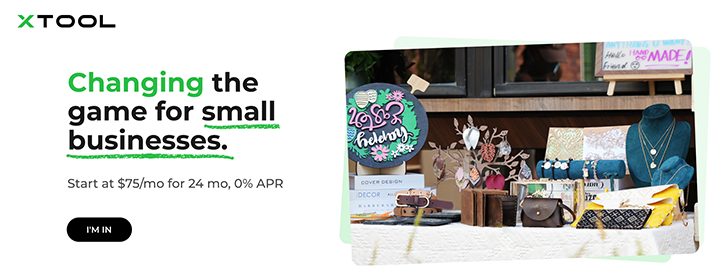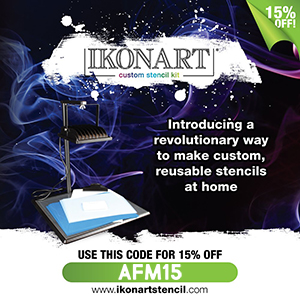Create a Personalized Composition Notebook Gift Box filled with goodies to thank your favorite teacher!

Teachers don't get enough appreciation, and one of my favorite ways to thank them is with something specially made just for them. When I was thinking of what to gift our favorite teachers this year, I had a cool idea but just couldn't find what I was looking for. In true Artsy-Fartsy Mama fashion, I decided to make it myself!
To bring this project to life, I combined wood cut with my xTool S1 laser cutting machine and custom stencils created my Ikonart kit to add the design. This Personalized Composition Notebook Gift Box turned out even better than I imagined, and we can't wait to pack these boxes full of surprises to thank our favorite teachers!

To make your own Composition Notebook Gift Box, you will need these supplies:
Box Supplies:
Box Supplies:
- xTool M1 or xTool S1 laser cutting machine
- Book Gift Box Design (personal use only)
- 3mm Basswood
- Acrylic Paint
- Paint Brushes
- Strong Adhesive
- Clamps (optional)
- Mini Hinges
Stencil Supplies:
- Composition Notebook Design Set (personal use only)
- Ikonart Custom Stencil Kit
- Scissors
- Acrylic Paint - black, red
- Chalk Paint Powder
- Squeegee
- Detail Brush (optional)
*Save 15% on Ikonart supplies with code AFM15
*Save extra 15% off on xTool selected materials: AFFMTRS15
Printables, designs, and cut files from Artsy-Fartsy Mama are for personal use only. You may use these files for personal projects, but you may not sell them. If you'd like to share this project digitally, share a link to this post/website only. Do not share a direct link to the file.

Upload the Notebook Gift Box design into xTool Creative Space. When you upload an SVG design, you need to make sure each part of the design is set for cutting, scoring, and/or engraving. For this project, everything in red needs to be cut and blue needs to be scored.
*This project is designed to be used with 3mm material. I do not recommend resizing the design.
Place a piece of 3mm basswood into the xTool S1 machine. Manually pull the laser box with your hand so that the red "+" is located on the material - it doesn't have to be centered. In XCS, you will see "Distance (mm)" in the right menu bar. Click on the target icon to the right of that space, and the machine will automatically measure your material.
*For more details on how to complete this step, be sure to check out my review of the xTool S1 Laser Machine!
Make sure that the design elements are within the marked bounding box in XCS, and then click the green "Process" button in the bottom right corner to proceed to cutting the project.

After removing the wood pieces from the machine, I would highly recommend cleaning the soot away from around the edges of the wood using a Magic Eraser or baby wipes to prevent making marks all over your hands/workspace, and to not have it flake off into the paint.

Paint both sides of each piece with white acrylic paint. Depending on the type of wood and paint you use, you may need to add more than one coat. Just make sure to allow each coat of paint to dry completely before adding another one on top.

Next, paint one side of the two longest pieces with black paint. These pieces will end up being the "spine" of the notebook, so only one side needs to be covered. Allow the paint to dry completely.
Create the Composition Notebook stencils:

The first thing you need to create an Ikonart stencil is with a printed design. Download the Composition Notebook design and print as dark as possible on either inkjet or laser Ikonart Printer Film. If you want to add a specific teacher's name, add it onto the image before printing.
The next step in the process is exposing the stencil film. Set up the exposure stand with UV LED Light by following the directions included in the kit. Ikonart Stencil Film is light sensitive, so be careful to keep it out of sunlight and bright lights before exposure. Cut a piece of the film the slightly larger than the design print.
Lay the piece of film down on the base of the stand with the textured side facing up. Place the printed design on top of the stencil film, making sure it's right-side up - meaning that you should be able to read the words printed on the design.
Lastly, place the clear exposure sheet (found in the stencil film pack) on top and press it down well to seal the design tight against the stencil film. Turn the exposure light on and expose the film for 35 seconds.

The next step in the stencil-making process is to washout, or rinse, the stencil to reveal the image on the film. Clip the exposed stencil film to the Ikonart clipboard with the shiny side (carrier sheet) touching the clipboard. Use a kitchen sink sprayer to rinse the stencil film with warm water until the design shows through and becomes completely clear. The washout process usually takes no more than 3 minutes.
Gently blot the excess water from the stencil, and hang or lay the stencil flat to dry for about 45 minutes. When the stencil is completely dry, you shouldn't see any water spots or discoloration.

Once the stencils are completely dry, cut the stencil images apart. Expose the stencils again for at least 2 minutes without the clear cover sheet on top. This extra exposure time will increase the durability of the stencils, helping you get as much use out of them as possible.
After use, it's extremely important to pair the stencil and carrier sheet up with the right sides together. You can either cut one corner of each stencil, or use a permanent marker and write the word "back" on the carrier sheets (shiny side) on the back of the stencils.

Make sure that both the stencil and the paint are COMPLETELY dry before moving on to this step!! If it's not, your stencil could stick to the wood permanently, ruining your project.
Remove the clear backing from the composition notebook cover stencils. Center the pattern stencil the bottom box piece. For the top piece, make sure the rounded corners are on the right side. Align the left edge of the cover stencil with the left side of the wood. Rub the stencils down onto the wood for a good hold and to get rid of any air bubbles.

Thicker paints, like chalk paint, is best to use with these stencils. Acrylic paint is a thinner consistency than chalk paint, so it's more likely to bleed under the stencil. To thicken the paint, mix in a little bit of chalk paint powder. This works with any brand or type of acrylic paint!
Pour some paint out on a palette or into a disposable cup and then add a little bit of powder. Stir it together with a craft stick until combined. Add a little more powder at a time until you get the consistency you want.
*If you're not sure what to kind of paint to use on your projects, Ikonart has a helpful list of paint and ink selections to help you out!
Apply a line of paint along the top edge of the stencil and gently pull the squeegee down to cover the entire design. Scrape away the excess and put it back into the paint bottle or mixing cup.
Chalk paint is thicker, but it also dries a lot quicker than regular acrylic paint. It's important to move a little quicker than you usually would with regularly painted projects.

Start at one corner and lift up the stencil to reveal the paint underneath. If you see any areas that you may have missed, carefully lay the stencil back down and scrape a little more paint over the area. Once the stencil has been removed, allow the paint to dry completely and wash the paint from the stencil immediately.
Washing Stencils:
For best results, wash stencils while the paint is still wet. To wash your stencil so that it can be used again and again, first get the clipboard wet so your stencil doesn't stick to it. Place the stencil on the clipboard with the textured side up, and lightly rub the stencil under cold running water to remove all the paint.
Do not rub or scrub the adhesive side of the stencil, and NEVER use anything other than water to wash the stencils. To prevent the stencil from breaking down, don't ever leave the stencils to soak.
Remove the stencil from the clipboard and lay it down with the adhesive side up. While the stencil is still wet, place the carrier sheet onto the stencil so that the word “BACK” is readable. Hang or lay the stencil flat to dry completely.

I'm making these gift boxes for multiple teachers, so one of my goals for this tutorial was to show you how to use the same stencils again and again.
* record scratch *
Instead, I am going to show you what happens if you are impatient and don't triple-check that the stencil is completely dry. On my last cover piece, I placed the stencil and applied the paint. When I peeled the stencil away - surprise! The stencil film stuck to the wood, making the stencil unusable for future use.
A more traditional design would have larger stencil area, which would be a lot easier (but still heartbreaking) when attempting to save the project. This design, however, is made of a kajillion small pieces of stencil film that I needed to attempt to remove.
Don't give up - it's not an impossible task. I found that I was fortunate to have reacted quickly. I used a hook tool to carefully peel the tiny stencil pieces off, one at a time. It took quite a while to clear that entire section on the left, but it looked great! After taking a break (an hour or so), the pieces were much harder to remove at this point. I was able to remove a majority of the film, but left some pieces that were extremely tiny, and luckily you can't even tell.
The point is, even the "pros" make mistakes!! Don't beat yourself up if your project doesn't go to plan. Just take a breath, and do what you can to fix it. Take a break away from the project and come back later if you are having strong feelings about it. Just don't give up!

Use a ruler to make a parallel line a little bit away from the straight edge of the cover pieces. Fill in the area between the line and edge with the same black paint used with the stencils. This painted edge gives the illusion of the binding that wraps around on the actual composition notebooks.

Once the paint has dried on all of the wood, gather all of the pieces together to start to assemble the gift box. You will also need a strong, quick-drying adhesive.

Assemble one side of the gift box at a time. They are both assembled the same way, but the only difference is that one side of the box will have wider pieces than the other: the top half will use the thinner pieces, and the bottom half will use the wide.
Gather the top cover piece, and all four lengths of wood with a thinner width measurement. Place the cover face-down on the workspace. Apply a thin line of adhesive along the side edge of the longest piece of wood.
Stand the piece up on the straight end of the cover piece, lining up the edges. Hold the piece in place until the glue is set (which is why I recommend something quick-dry), or use a clamp to hold it in place.

Next, apply a thin line of adhesive to the bottom and one end of the shortest pieces. Place the piece on the outer side of the guideline, and make sure the end is aligned with the "book spine" and press the pieces together. Repeat this for the opposite side. For the last piece, apply a thin line of adhesive along the bottom edge and both ends. Line the piece up with the scoreline, and press it into place between the two side pieces. Align the corners and press them together.
Allow the adhesive to set completely and use clamps, if necessary.

Use a detail brush to paint all of the edges around the cover and the top of the box half with black paint. Cover the edges that will show as the "pages" with white paint. Allow the paint to dry completely.












Place the two halves of the box together. Stand the box so that the "spine" is at the top. Apply a small amount of adhesive to two mini hinges. Align the edges of the box together and hold tightly (use a clamp, if necessary). Place the hinges on the box, about 1/2" or so away from the edges, with the hinge lined up with the seam. Press the hinges down well and allow the adhesive to set.
Now that the composition notebook gift box is complete, it's time to personalize it!

Place the stencil of choice (this one is provided in the design) over the lines under the "Composition Book" title. You can put it on straight, or at an angle.
Choose your paint of choice. I wanted to try a multi-colored effect (similar to our neurodivergent hoodie project), so I mixed a little bit of bright pink, yellow, and blue acrylic paints with chalk powder to thicken them up.

Add a little bit of each color of paint at the top end of the stencil. Use the squeegee to drag the paint down, and then go over the stencil, pulling it down a few more times to help blend the edges of the colors together.

Slowly peel the stencil away, making sure that the design has been fully painted on. If not, lay the stencil back down and go over it again with a little more paint. If it looks good as you pull the stencil away, remove it completely and allow the paint to dry. Don't forget to wash the stencil!

I absolutely love the colorful gradient on this Composition Notebook Gift Box! The "Teach" design might be simple, but there is so much you can do with it to make each gift box unique.

If you really want to personalize the gift box, I've got great news! Before printing the stencil design, you can add in your favorite teacher's name, or any other personalized title to make a stencil for the gift box. Place the stencil on the box, either straightened with the lines or at an angle. Press it down flat to remove any air bubbles.

Again, use any color of acrylic paint (thicken it up as necessary) and use the squeegee to cover the stencil.

Peel the stencil away from the box, checking for any missed spots. Re-apply paint, if necessary. Once covered, remove the stencil completely and wash it immediately. Allow the paint to dry completely.

I think this Personalized Composition Notebook Gift Box with the teacher's name on it is so fun, and that it looks so professional since the name has been added to it using a stencil. Want to create even more gifts for this specific teacher? Reuse that stencil!!

Now that the box is finally completed, fill it up with all kinds of goodies to celebrate your favorite teachers. This gift box will fit a gift card in it perfectly, and also has some extra room for gum and candy. Once the box is emptied, teachers can reuse the box to hold school supplies, jewelry, or stand it up (empty) on a desk or shelf to put on display.
Important: Don't forget to add a special note written by your child! Over anything else, this is something that almost every teacher has said to be one of their favorite things to receive.

Honestly, I think this is definitely one of my favorite projects that I have made using my Ikonart kit - I especially love how I was able to combine custom stencils with laser cutting to bring this project to life. I don't even want to THINK about trying to create this using vinyl... Yeesh.
These Personalized Composition Notebook Gift Boxes are definitely going to be popular teacher gifts! I hope I've inspired you to give this project a try. If you've made your own stenciled projects, I would love to see your creations! Share them on Instagram, Facebook, or leave a comment/photo on the project pin on Pinterest! #AFMCrafts
Don't forget to Pin, Like, and Share!













